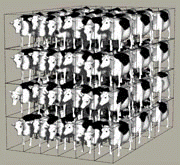Animal Science, Department of

World Congress on Genetics Applied to Livestock Production: 3rd (1986)
Date of this Version
1986
Abstract
Development of selection objectives for beef cattle requires consideration of the available feed resources. In production systems with access to liberal quantities of harvested feeds of relatively high quality, selection to improve economic efficiency will normally favor animals with high genetic potentials for the primary production traits. However, these highly productive types may also have relatively high maintenance requirements and be less efficient when nutrient restrictions prevent expression of genetic differences in appetite. This, important genotype × environment interactions may be observed. In range environments, animals may be restricted in the amount of forage that can be harvested. These restrictions usually arise from an inability of the animal to increase grazing times or geed intake rates beyond certain levels imposed by the sward and by innate animal requirements for rest and rumination. In addition, maintenance requirements are often elevated in range environments, thereby further limiting the increases in productive capacity that can be accommodated. Under conditions of nutrient restriction, antagonistic phenotypic relationships may also be observed among production traits (such as milk production and reproduction). The nature of these relationships must be considered in the development of selection criteria.


Comments
Published in 3rd World Congress on Genetics Applied to Livestock Production, edited by Gordon E. Dickerson and Rodger K. Johnson, 4 vols. (Lincoln: University of Nebraska Institute of Agriculture and Natural Resources, 1986). Copyright © 1986 Board of Regents University of Nebraska.